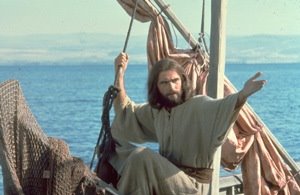There are various stories that are only tangentially related to Bible films that I thought might be worth mentioning anyway as they might be of interest to some. Most of which are, well, a bit odd.
1 -
MTV Splash Page reports that the latest draft of Jim Uhls' script for
Rex Mundi is finished, and that the producers, who include star Johnny Depp, are hunting for a director. Depp will play Dr. Julien Sauniere and if that name sounds familiar then you're probably thinking of curator
Jacques Saunière from 2006's
The Da Vinci Code. It's neither plagiarism nor coincidence:
Bérenger Saunière was a priest who figured prominently in the conspiracy theories that inspired both Dan Brown's novel and the comic book that
Rex Mundi is based on which also concerns "the Holy Grail and a descendant of Jesus Christ". The major difference between the two seems to be that
Rex Mundi seems to suppose that Martin Luther was assassinated before the reformation got going and that, as a result, Roman Catholic Church now dominates the world.
2 - And it looks like 2009 or 2010 might be the year of the adapted comic books that sound a bit like
The Da Vinci Code.
Gale Anne Hurd is the producer for an adaptation of the comic-book series about a woman who discovers that she's the latest in a long line of holy female warriors descended from Jesus and Mary Magdalene.
The Magdalena (not to be confused with the evangelical women's film
Magdalena) will feature ex-Bros star Luke Goss (who recently played Xerxes in
One Night With the King) as an agent who works with the Inquisition. More from
The Hollywood Reporter.
3 - There's no knowing what Lars von Trier's psychological thriller / horror film
Antichrist will be like, but
Variety is reporting that it has finally raised its $11 million budget. Also in
Variety is news that
Last Temptation of Christ's Willem Dafoe will star. Will he be playing the eponymous villain, and if so is this the first time that an actor has played both Christ and the Antichrist? (Max von Sydow's turn as "The Tracker" in
What Dreams May Come doesn't really count).
4 - Staying with
Variety, they are reporting that Mark Ruffalo is going to direct his first film
Sympathy for Delicious. Ruffalo will also be in front of the camera along with James Franco and script writer Chris Thornton. Thorton will play the role of wheelcahir bound faith healer "Delicious" Dean O'Dwyer, whilst Ruffalo stars as "a Jesuit priest who tries to help him come to terms with the limits of his gift".
Thanks to
Peter Chattaway for all of the above.
5 - Meanwhile,
Jeffrey Overstreet reports that Martin Freeman is starring in a comedy about two rival schools seeking to outdo each other with their Nativity plays. Jeffrey got the story from
Variety which claims that Ashley Jensen of
Extras fame will also have a role. No mention of Ricky Gervais or Stephen Marchant, who worked with Freeman in
The Office and Jensen in
Extras. Incidentally the writer of the
last Nativity movie, Mike Rich, has penned a script for
Secretariat.
6 - The release date for the highly anticipated
Prince of Persia has been pushed back by almost a year. Whereas it was originally scheduled for release June 2009,
Hollywood Reporter says it's looking like it won't arrive until May 2010.
7 - Finally,
Film.com have an article on Steve Coogan's
Hamlet 2. They report that whereas a film featuring a "Sexy Jesus" would normally be getting slammed by Conservative groups,
Hamlet 2 isn't being because they criticise the ACLU.
 British filmmaker Peter Greenaway recently performed a one night only digital show using Da Vinci's "Last Supper". Greenaway projected a film on top of Da Vinci's original painting to an audience in the refectory of Santa Maria delle Grazie. There are two tantalising minutes of footage available at The Guardian's website which do enough to suggest that it would have been really quite impressive to be there without really satisfying the curiosity of those who weren't. Thankfully the paper also has a handful of images from the evening, reviews by Robert Booth and Jonathan Jones, and an audio file of the two of them in conversation with Greenaway himself. Both Booth and Jones give a good impression of what it was like to witness the show. The following snippet is Booth's:
British filmmaker Peter Greenaway recently performed a one night only digital show using Da Vinci's "Last Supper". Greenaway projected a film on top of Da Vinci's original painting to an audience in the refectory of Santa Maria delle Grazie. There are two tantalising minutes of footage available at The Guardian's website which do enough to suggest that it would have been really quite impressive to be there without really satisfying the curiosity of those who weren't. Thankfully the paper also has a handful of images from the evening, reviews by Robert Booth and Jonathan Jones, and an audio file of the two of them in conversation with Greenaway himself. Both Booth and Jones give a good impression of what it was like to witness the show. The following snippet is Booth's:



























